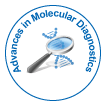Research Article
Tumor Genomic Profiling Reports from Different Vendors: A Comparison with Respect to Clinical Action Ability of the Provided Data
Yuriko Mori*, Victor Levenson and Jeffrey Otto
CHI Institute for Research and Innovation, Center for Translational Research, Baltimore, USA
- *Corresponding Author:
- Yuriko Mori
CHI Institute for Research and Innovation
Center for Translational Research
Baltimore, USA
Tel: 443-948-5435
Fax: 443-948-5421
Email: YurikoMori@gmail.com
Received date: July 03, 2016; Accepted date: August 02, 2016; Published date: August 05, 2016
Citation: Mori Y, Levenson V, Otto J (2016) Tumor Genomic Profiling Reports from Different Vendors: A Comparison with Respect to Clinical Action Ability of the Provided Data . Adv Mol Diag 1:110.
Copyright: © 2016 Mori Y, et al. This is an open-access article distributed under the terms of the Creative Commons Attribution License, which permits unrestricted use, distribution, and reproduction in any medium, provided the original author and source are credited.
Abstract
Background: Next generation sequencing (NGS) of selected genes is an expanding field of solid tumor characterization. Multiple vendors offer this service, but panel design and policies on interpretive reporting are variable. This study compared reports from selected vendors, with emphasis on clinical Action ability reporting.
Methodology: DNA aliquots of five breast and five colorectal cancers were sent to providers offering the following solid tumor NGS tests: Foundation oneTM, StrandAdvantageTM, CANCP, and GeneTrailsTM. The interpretive reports were compared for the reporting of clinically actionable variants.
Results: Detection of mutants was mostly consistent (17 of 21, 81% concordant), while detection of copy number variants was highly discordant (6 of 23, 26.1% concordant). Discordance of copy number variation appeared to be primarily due to difference in analytical sensitivity. Actionable variants with approved targeted therapies for the same tumor type were detected and interpreted uniformly by all tests. Reporting of variants with other action ability was variable, largely due to difference in panel design and analytical sensitivity, and, to a lesser degree, to different annotation policies. Actionable variant reporting by Foundation one provided better coverage of clinical trials for targeted therapies while strand advantage uniquely covered chemotherapeutic response modulation. GeneTrails provided moderate coverage of clinical trials despite its small gene panel size. Utility of rearrangement targets in Foundation one and StrandAdvantage panel was not evident, due to the tumor type assessed.
Conclusion: All enrolled tests reported actionable variants with FDA-approved target therapy for the specific tumor type with consistent clinical interpretations. In contrast, reporting of variants with other Action ability was heavily impacted by panel design, reporting policy, and annotation policy. Larger studies will be needed to quantify the qualitative differences outlined above and evaluate the benefit to the patient in order to improve the practice of precision medicine in the future.

 Spanish
Spanish  Chinese
Chinese  Russian
Russian  German
German  French
French  Japanese
Japanese  Portuguese
Portuguese  Hindi
Hindi